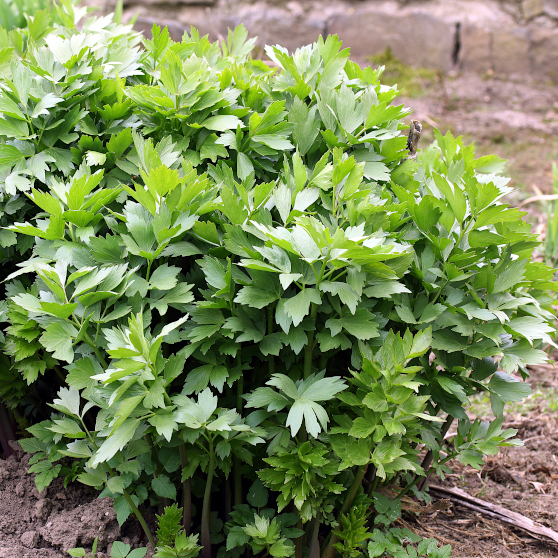Levisticum officinale
Liebstöckel, maggikraut, lavas, luststock
Englische Bezeichnung: Lovage, Hart-Wort, Sea Parsley
Spanische Bezeichnung: Levistico

Familie
Doldenblütler (Apiaceae)
Hauptbestandteile:
Ätherische Öle (hauptsächlich beta-Phellandren, beta-Terpinylacetat, beta-Myrcen und trans-beta-Ocimen sowie Z-Ligustilid),Cumarine (5-Methoxy-Psoralen, 8-Methoxy-Psoralen, Psoralen), Essigsäure, Engelsäure, beta-Sitosterol-beta-D-glucosid, Kaffeesäure, Ferulasäure, Furfural, Imperatorin, Pretazettin, Sedanenolid, Z-Ligustilid
Verwendung:
Wurzel, Frucht (Samen), Blatt, junger Blattstiel
Wirkungsweisen:
-
Antiviral
-
Antibakteriell
-
Aromatisch
-
Bitteres Tonikum
-
Karminativum (beruhigend auf die Mobilität des Verdauungstraktes)
-
Kreislaufanregend
-
Stimulierend
-
Schweißtreibend
-
Harntreibend
-
Menstruationsfördernd
-
Schleimlösend
-
Immunstimulierend
Geschmack:
Säuerlich, Bitter, Scharf
Energie:
Wärmend
Ernte-Hinweise:
-
Die Wurzel wird frisch geerntet, wenn die Pflanze mindestens ein paar Jahre alt ist (am besten im Herbst oder Frühjahr)
-
Früchte können geerntet werden, wenn sie reif sind, bevor sie austrocknen
-
Junge austreibende Blattstiele werden im Frühjahr geerntet, wenn sie 10-12 cm lang sind, um wie Sellerie gegessen zu werden, während junge Blätter für die kulinarische Verwendung geerntet werden
Liebstöckel wurde wahrscheinlich aus dem Iran und Afghanistan nach Europa eingeführt. Der Samen und die Wurzel wurden schon damals bei inneren Schmerzen, Blähungen und Schlangenbissen verwendet, sowie als harntreibendes und menstruationsförderndes Mittel eingesetzt.
Liebstöckelsamen sind sehr aromatisch und haben stark beruhigende Wirkung auf die Verdauungsorgane und verdauungsfördernde bittere Eigenschaften; sie wurden vor den Mahlzeiten konsumiert, um die Verdauungssekrete zu stimulieren und Blähungen zu lindern
Die warmen und aromatischen Qualitäten der Liebstöckelwurzel fördern die Durchblutung und sind auch mit den wärmenden, schweißtreibenden Eigenschaften verbunden; es kann verwendet werden, um Fieber zu senken oder um die Sekretion von trockenen Schleimhäuten im ganzen Körper anzuregen.
Das kann die Gebärmutterschleimhaut einschließen, wo diese erwärmende schweißtreibende Eigenschaft zu einer emmenagogischen Wirkung führen und das Einsetzen der Menstruation fördern kann, besonders bei Personen mit verzögerter Menstruation.
Die Atemmungorgane werden auch durch die anregende aromatische Wirkung der Wurzel beeinflusst; sie regt die Sekretion in diesen Membranen an, verdünnt den Schleim und erleichtert die Ausscheidung, was denjenigen zugute kommen kann, die an unter einem trockenen Hals, Kehlkopfentzündung, Erkältungen, Grippe, Infektionen der unteren Atemwege oder Raucherhusten leiden.
Family
Apiaceae
Parts Used:
Root, fruit (seed), leaf, young leaf stem
Key Constituents:
Volatile oils (primarily beta phellandrene, beta-terpinyl acetate, beta-myrcene, and trans-beta-ocimene, and Z-ligustilide), coumarins (5-methoxy-psoralen, 8-methoxy-psoralen, psoralen), acetic acid, angelic acid, beta-sitosterol-beta-D-glucoside, caffeic acid, ferulic acid, furfural, imperatorin, pretazettine, sedanenolide, z-ligustilide
Harvesting Guidelines:
– The root is harvested fresh when the plant is at least a few years old (best harvested in the fall or spring)
– Fruits can be harvested when ripe, before drying out
– Young emerging leaf stems are harvested in spring when 10-12 cm long to be eaten like celery, while young leaves are harvested for culinary use
Properties:
-
Antiviral
-
Antibacterial
-
Aromatic
-
Bitter tonic
-
Carminative
-
Circulatory
-
Stimulant
-
Diaphoretic
-
Diuretic
-
Emmenagogue
-
Expectorant
-
Immune Stimulant
Taste:
Acrid, Bitter, Pungent
Energy:
Warming
Lovage was likely introduced to Europe from Iran and Afghanistan.
The seed and root were traditional indicated for internal pains, flatulence, and snake bites, and used as a diuretic and emmenagogue.
Lovage seeds are very aromatic and have potent carminative and digestive bitter properties; they have been consumed before meals to stimulate digestive secretions and to lessen gas and bloating
The warm and aromatic qualities of lovage root enhance circulation and are also related to its heating diaphoretic properties, it may be used to break a fever or to stimulate secretions from dry mucous membranes throughout the body. This can include the uterine lining, where this heating diaphoretic property can lead to an emmenagogue effect and promote the onset of menstruation, especially in those with delayed menses.
The respiratory tissues are also affected by the stimulating aromatic effect of the root; it stimulates secretions in these membranes, thins mucus, and facilitates its expulsion, providing an expectorant effect that may benefit those experiencing a dry throat, laryngitis, colds, flu, lower respiratory infections, or smoker’s cough.
Familia
Apiaceae
Partes aprovechables:
Raíz, fruto (semilla), hoja, tallo de hoja joven
Principales Constituyentes:
Aceites volátiles (principalmente beta-felandreno, acetato de beta-terpinilo, beta-mirceno y trans-beta-ocimeno, y Z-ligustilida), cumarinas (5-metoxi-psoraleno, 8-metoxi-psoraleno, psoraleno), ácido acético, ácido angélico, beta-sitosterol-beta-D-glucósido, ácido cafeico, ácido ferúlico, furfural, imperatorina, pretazetina, sedanenolida, z-ligustilida
Indicaciones de Cosecha:
– La raíz se recolecta fresca cuando la planta tiene al menos unos años de edad (se recolecta mejor en otoño o primavera)
– Los frutos se cosechan cuando están maduros, antes de que se sequen
– Los tallos jóvenes de las hojas emergentes se cosechan en primavera cuando tienen 10-12 cm de longitud para ser consumidos como el apio, mientras que las hojas jóvenes se cosechan para uso culinario
Propiedades:
– Antiviral
– Antibacteriano
– Aromático
– Tónico amargo
– Carminativo
– Circulatorio
– Estimulante
– Diaforético
– Diurético
– Emenagogo
– Expectorante
– Estimulante inmunológico
Sabor:
Ácido, Amargo, Picante
Energía:
Calentador
El apio de monte se introdujo probablemente en Europa desde Irán y Afganistán.
La semilla y la raíz se ingerían tradicionalmente para los dolores internos, las flatulencias y las mordeduras de serpiente, y se utilizaban como diurético y emenagogo.
Las semillas de levístico son muy aromáticas y tienen potentes propiedades carminativas y digestivas amargas; se han consumido antes de las comidas para estimular las secreciones digestivas y disminuir los gases y la hinchazón
Las cualidades cálidas y aromáticas de la raíz de apio de monte mejoran la circulación y también están relacionadas con sus propiedades diaforéticas de calentamiento; puede utilizarse para bajar la fiebre o para estimular las secreciones de las membranas mucosas secas de todo el cuerpo. Esto puede incluir el revestimiento uterino, donde esta propiedad diaforética de calentamiento puede conducir a un efecto emenagogo y promover el inicio de la menstruación, especialmente en aquellos con retraso de la menstruación.
Los tejidos respiratorios también se ven afectados por el efecto aromático estimulante de la raíz; estimula las secreciones en estas membranas, adelgaza la mucosidad y facilita su expulsión, proporcionando un efecto expectorante que puede beneficiar a quienes padecen sequedad de garganta, laringitis, resfriados, gripe, infecciones de las vías respiratorias bajas o tos de fumador.






































